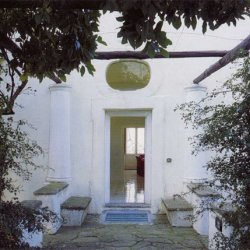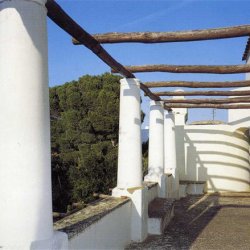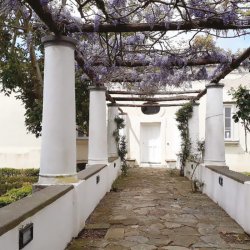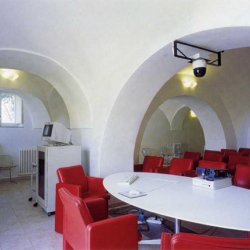Casa Orlandi
Casa Orlandi, an architectural episode in which themes and models of the traditional Capri house converge, constitutes the link between two districts of Anacapri: Timpone and Le Boffe. Its original layout dates back to the early decades of the eighteenth century, when the new church of San Michele was built in the nearby convent complex of Carmenlitane, completely renovated, based on a project (1719-20) by D. Antonio Vaccaro.
Before this intervention we must imagine, on the site of the current house, cisterns and peasant structures belonging to the Teresians. Around the mid-nineteenth century, and precisely in 1848, the Orlandi family bought the "country casino", which became Casa Orlandi. The first known owner was the politician Giuseppe Orlandi, promoter of the rolling stock between Capri and Anacapri; the second, well known, was Edwin Cerio, who was responsible for the restructuring of the work carried out in the 1930s. To the eighteenth-century "casino" we can trace the largest cistern of the cellar, the room with a mirror vault on the ground floor that overlaps it and - perhaps - the one, with the same type of vault, corresponding to the first room after the entrance, on the first floor. The south facing rooms with the bedroom, the kitchen and the entrance hall date back to an expansion phase.
The current Casa Orlandi consists of two floors with two distinct gardens, one on the ground floor (the largest and oldest) and one on the first floor. It is accessed from the upper floor through the main entrance, consisting of an avenue with a pergola of rustic Doric columns on bases connected to the wall and connected, at the top, by a pergola in chestnut poles.
The ground floor is reached from another entrance, also located on Via Finestrale, but at a lower level, passing through the garden-vegetable garden. The lower entrance was to be the entrance to the "country casino" with cisterns, vegetable garden and garden, or rather the first nucleus of what will become Casa Orlandi. The name of the rooms, indicated here to illustrate the architectural type, is to be understood as referring to the first work of the current use as a Congress Center of the "Federico II" University, which has not altered the configuration of the spaces in any way. The upper entrance attracts attention from the gate for the presence of the colonnaded pergola, with square spans, which monumentalizes the house and constitutes a precious testimony of the traditional architectural culture of the island. The alignment of the first room with the avenue of the pergola allows you to see the view from the small entrance hall; from here you pass to the living room and then to the terrace with columns, which runs along the entire facade of the first floor and overlooks the sea. The ground floor is characterized by a sequence of rooms from the sleeping area, respectively to the left and right of the main entrance. Here, with the reduced thickness of the portico, Cerio had to measure himself to create the very small bedroom, articulated on two levels, equipped with hallway, a small bathroom and meticulously designed furniture.
Upstairs there are the two main rooms, covered with mirrored vaults, and the "study" of Cerio which, together with the terrace with the pergolas, constitute the advanced body of the building. On the back, on the left are the bedroom, also with a mirrored vault, a small room with a barrel vault and the bathroom, on the right a small room, the kitchen and the stairs that lead to the roof and floor inferior. The first staircase is inserted in a loggia covered by a mirrored vault; the second, which starts directly from the kitchen, is the only indoor connection with the lower floor, directly from the entrance to the first floor. From the kitchen, going out onto the terrace and crossing an arch, you reach the "studio" of great plastic effect, embellished, in the south-east corner, by the sculptural chimneys. It was presumably built between 1930 and 1934, during the renovation of the house and the arrangement of the gardens. The small window is oriented towards the most beautiful glimpse of the Gulf of Naples that could be seen from the desk, actually made up of the same shelf as the sill that leans against the oblique wall.










